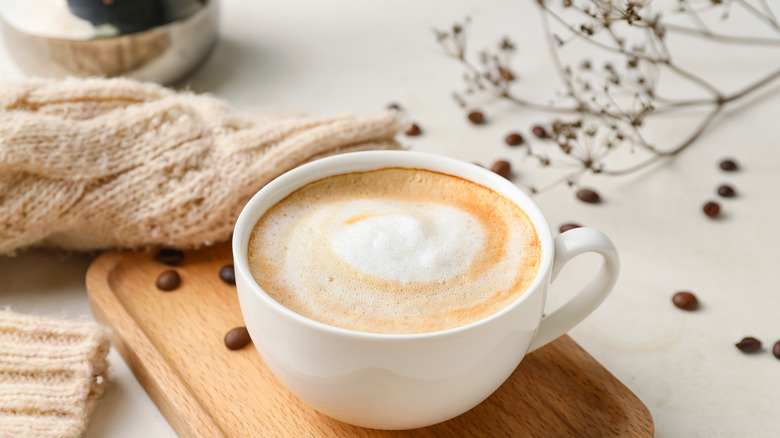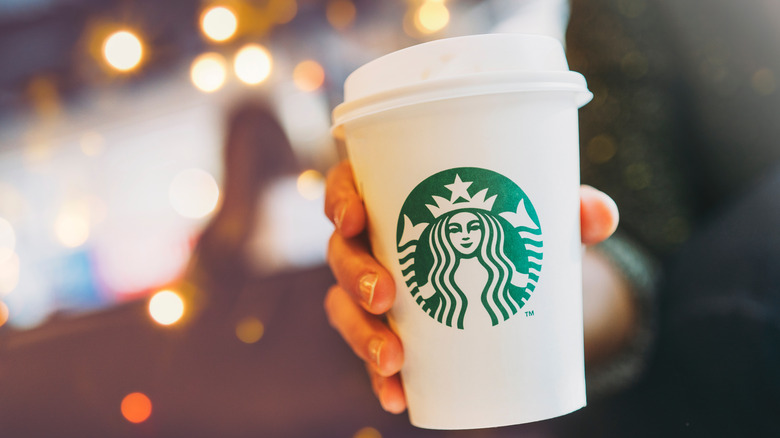The Strange Reason Nonfat Milk Almost Wasn't Included At Starbucks
While it is now one of the world's most famous and recognizable coffee shops, Starbucks comes from rather humble beginnings. In 1971, three friends and academics, Jerry Baldwin, Gordon Bowker, and Zev Siegl, opened a single coffee shop near Pike's Place Market in Seattle, Washington. The educated literary lovers took inspiration from the classic Herman Melville novel Moby Dick for their new coffee shop's name, according to Britannica.
By the early 1980s, the founders opened up three other locations, but Starbucks might have simply remained a local Seattle favorite, were it not for a young salesman named Howard Schultz. Schultz, who originally worked for a kitchen equipment company called Hammarplast, which supplied Starbucks with drip-coffee makers, was so impressed with the new coffee shop's popularity that he wanted to join the team. In 1982, he was hired as the head of marketing, and soon he was on a mission to grow Starbucks into the global coffee brand that it is today.
An authentic Italian coffee bar experience
In 1983, Schultz visited Milan, Italy, where he was impressed by the large number of coffeehouses and cafes he saw. Inspired by the coffee culture abroad, Schultz decided he wanted to turn Starbucks into a chain of coffeehouses that would bring the Milan experience to the rest of America. And he didn't just want to sell ordinary coffee; he wanted to deliver the authentic Italian coffee bar experience to the American public, according to Starbucks.
Soon, Schultz added traditional Italian lattes and cappuccinos to the Starbucks menu. But it turns out Howard Schultz was also a bit of a purist. Initially, Schultz wanted to stick with only serving authentic lattes and cappuccinos, even if customers wanted to make some alterations to their own orders. This soon became an issue, because many health-conscious Americans preferred to drink their espresso with nonfat milk. However, because lattes and cappuccinos were traditionally served only with whole-fat milk at the coffee bars in Italy, Schultz was reluctant to change the Starbucks recipe to include a nonfat option, according to the Starbucks Archive. He also believed that nonfat options simply didn't taste as good, and he wanted only to offer the highest quality of drinks at Starbucks. However, in the end, the customers won out.
Customers wanted a nonfat option
Schultz saw with his own eyes that Starbucks was losing customers simply because of the company's refusal to offer of nonfat milk. After seeing a customer walk out of the shop because they did not have a nonfat milk option, Schultz agreed to start serving nonfat lattes and cappuccinos, per the Starbucks Archive. The decision eventually helped to usher in Starbucks' new motto: Just say yes. Or, put into more common terms, the customer is always right.
In hindsight, it seems a bit like a no-brainer that adding more popular substitutes to the menu was the right move. Clearly, the decision was the correct one, because Starbucks is now one of the most successful coffee shops in the world, with 33,833 stores worldwide in over 70 countries and a reported revenue of over 19 billion dollars as of 2020, according to Statista. Now, they offer plenty of modifications for their drinks, far beyond nonfat milk. In fact, Starbucks advertises "more than 170,000 ways to customize beverages" so "customers can create a favorite drink that fits their lifestyle," per Starbucks Stories. These days, everyone can customize their drinks in a number of different ways, from selecting their favorite types of milk, including 2 percent, soy, almond, and coconut, to adding many varieties of syrups, flavorings, and sweeteners. Clearly, giving customers the option to customize their beverages to their liking has only helped Starbucks grow into the coffee giant that it is today.


